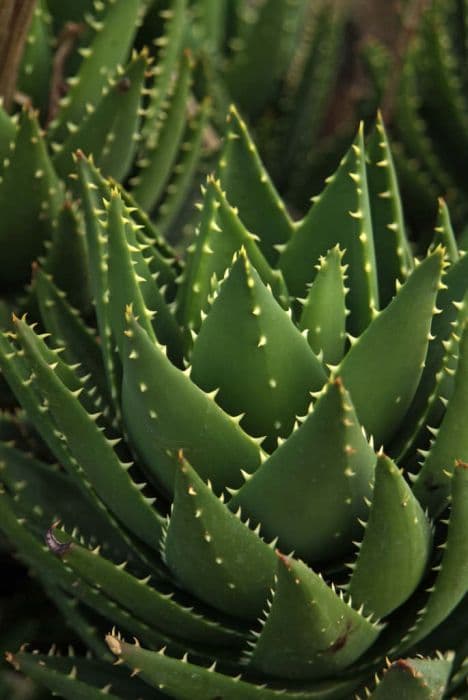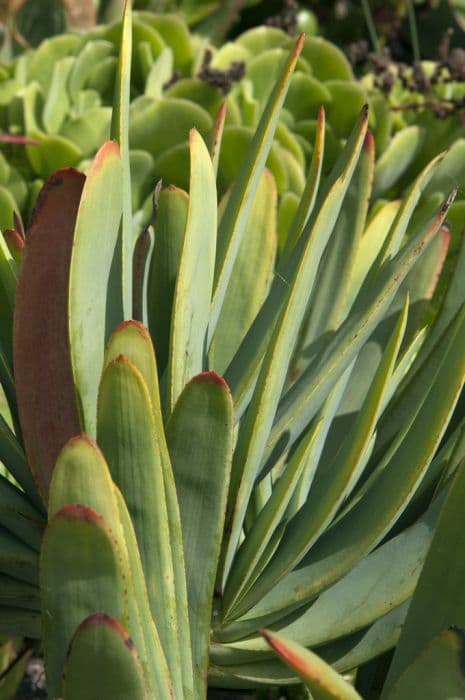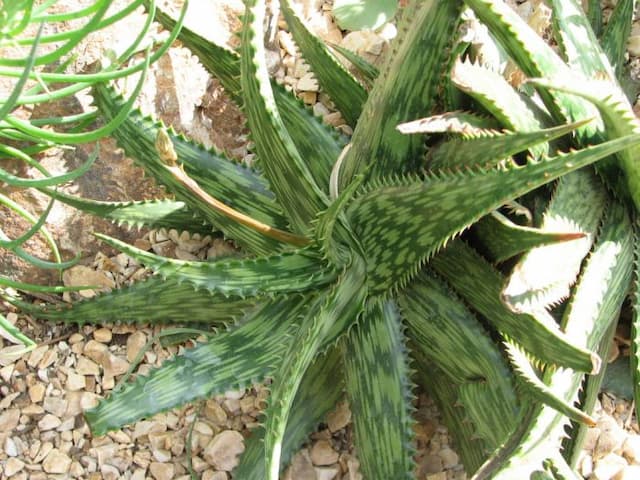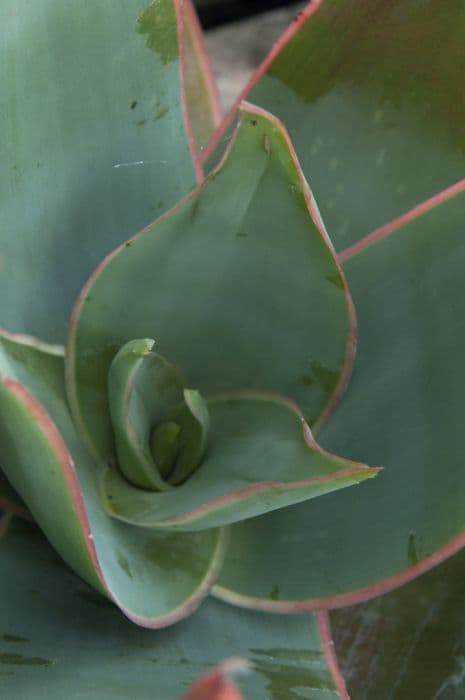Red hot poker Kniphofia triangularis

ABOUT
The plant commonly known as Red Hot Poker or Torch Lily is a perennial that sports a distinctive flowering structure. Its flowers are densely packed on a spike and exhibit a gradation of color, typically ranging from red at the top to yellow at the bottom, giving the impression of a flickering flame. The blossoms are tubular and frequented by hummingbirds and other pollinators. The foliage forms a clump of grass-like, arching leaves that are narrow and pointed, adding textural interest even when the plant is not in bloom. The leaves remain mostly evergreen in milder climates, contributing to the landscape year-round. The overall appearance of Red Hot Poker is one of vibrant, fiery spikes rising above a base of lush greenery, making it a visually striking addition to garden settings.
About this plant
 Names
NamesFamily
Asphodelaceae
Synonyms
Red Hot Poker, Torch Lily, Tritoma
Common names
Kniphofia linearifolia, Tritoma triangularis, Tritoma linearifolia.
 Toxicity
ToxicityTo humans
Kniphofia triangularis, commonly known as red hot poker, is not widely recognized as a highly toxic plant to humans. However, as with many garden plants, it may cause irritation if ingested or if the sap comes into contact with skin or eyes. In general, eating parts of this plant might result in stomach upset, vomiting, or diarrhea. It is always prudent to keep all plants out of the reach of children and to avoid ingesting parts of ornamental plants, as they are not intended for consumption.
To pets
Red hot poker is not generally known to be significantly toxic to pets either. However, similar to humans, ingestion could potentially cause mild gastrointestinal upset in animals, such as vomiting or diarrhea. It is always a good practice to prevent pets from consuming ornamental plants, as they may have varying reactions including irritation to the mouth and gastrointestinal tract if chewed or ingested. If you suspect your pet has ingested a potentially harmful plant, you should contact a veterinarian.
 Characteristics
CharacteristicsLife cycle
Perennials
Foliage type
Evergreen
Color of leaves
Green
Flower color
Orange
Height
2 feet (0.6 meters)
Spread
1.5 feet (0.45 meters)
Plant type
Herb
Hardiness zones
5
Native area
South Africa
Benefits
 General Benefits
General Benefits- Attracts Pollinators: Kniphofia triangularis, commonly known as red hot poker, attracts bees, butterflies, and hummingbirds, contributing to the pollination of the garden.
- Landscape Focal Point: With its striking spikes of brightly colored flowers, the red hot poker can serve as an eye-catching focal point in a garden design.
- Drought Tolerance: Once established, the red hot poker is drought-tolerant, making it suitable for xeriscaping and low-water gardens.
- Easy Maintenance: It requires minimal maintenance once established, as it is generally resistant to pests and diseases.
- Long Blooming Season: The plant has a long blooming season, which can provide color in the garden from spring to late summer.
- Versatility: Red hot poker can be used in a variety of garden styles, including perennial borders, rock gardens, and wildflower meadows.
- Deer Resistance: The plant is relatively resistant to deer, which makes it a favorable choice for gardens in areas with a high deer population.
 Medical Properties
Medical PropertiesThis plant is not used for medical purposes.
 Air-purifying Qualities
Air-purifying QualitiesThis plant is not specifically known for air purifying qualities.
 Other Uses
Other Uses- Kniphofia triangularis, commonly known as Red Hot Poker, can be used as cut flowers for indoor decorations due to their long-lasting and striking blooms.
- The nectar-rich flowers are excellent for attracting hummingbirds and butterflies to the garden, promoting biodiversity.
- The plant can be used in a xeriscaping scheme, as it is drought-tolerant once established, helping to conserve water.
- Red Hot Poker can serve as a structural plant in garden design, providing vertical interest with its tall flower spikes.
- When dried, the seed pods of Kniphofia triangularis can be used in floral arrangements for their unique texture and form.
- The fibrous nature of the plant makes it a potential candidate for crafting natural twine or rope, although this is not a common use.
- The contrast between the foliage and the bright flowers can be used in garden landscapes to create visual focal points.
- As a hardy species, Red Hot Poker can be planted to stabilize soil in erosion-prone areas.
- The plant can be integrated into a wildlife garden to provide shelter for small animals and insects among its dense foliage.
- Red Hot Poker leaves can be used as a natural mulch to suppress weeds and retain soil moisture once they are cut and dried.
Interesting Facts
 Feng Shui
Feng ShuiThe plant Red Hot Poker is not used in Feng Shui practice.
 Zodiac Sign Compitability
Zodiac Sign CompitabilityThe plant Red Hot Poker is not used in astrology practice.
 Plant Symbolism
Plant Symbolism- Attention-Grabbing: Due to its bright, torch-like flowers, Kniphofia triangularis, commonly known as "Red Hot Poker," symbolizes a call for attention or to stand out in a crowd.
- Stimulating: The vibrant colors and unique shape of the Red Hot Poker flower can symbolize stimulation or a spark of interest, as they can invigorate the senses and draw the eye.
- Strength: Its sturdy and upright growth habit can represent strength and resilience, as the Red Hot Poker is able to withstand tough conditions.
- Purity: The luminous flowers can also stand for purity and cleanliness, asserting a bold presence in the clarity of their fiery hues.
- Playfulness: With their whimsical appearance, resembling a flaming torch, Red Hot Poker plants can symbolize playfulness or a fun disposition.
 Water
WaterRed Hot Poker should be watered regularly, aiming for at least an inch of water per week. During hot, dry periods this may increase to twice a week. It's important to avoid overwatering as this can lead to root rot. Water at the base of the plant to keep the foliage dry and reduce the risk of disease. For established plants, a deep watering that provides about a gallon of water per plant per week should suffice, adjusting as necessary for climate and soil conditions.
 Light
LightRed Hot Poker thrives in full sunlight, which means it should receive at least six hours of direct sunlight daily. The ideal location would allow for ample morning sunlight, which is less intense, while still providing exposure to the stronger afternoon rays. Avoid heavily shaded areas as this can hinder the plant's growth and flowering potential.
 Temperature
TemperatureRed Hot Poker plants are hardy and can endure temperatures as low as 14 degrees Fahrenheit but prefer the range between 50 to 80 degrees Fahrenheit. They perform best in warmer climates and should be protected or mulched in the winter to survive colder temperatures. In regions with harsh winters, planting them in a spot that receives winter sunlight can be beneficial.
 Pruning
PruningRed Hot Poker requires pruning to remove spent flower stalks and to maintain its shape. Pruning should be done in the late summer or fall, after flowering has finished. Cut the flower stalks down at the base of the plant. Additionally, remove any damaged or dead foliage to encourage new growth. Pruning yearly will promote a tidy appearance and vigorous health.
 Cleaning
CleaningAs needed
 Soil
SoilRed hot poker (Kniphofia triangularis) thrives in well-drained soil with a pH range of 6.0 to 6.5. A mix of loamy soil, with added compost and a bit of sand for improved drainage, works best for this plant. Regular amendments with organic matter help maintain soil fertility and structure.
 Repotting
RepottingRed hot poker plants (Kniphofia triangularis) don't require frequent repotting and can be done every 3-5 years. Repot when the plant shows signs of being root-bound or when the soil is noticeably depleted.
 Humidity & Misting
Humidity & MistingRed hot poker plants (Kniphofia triangularis) are tolerant of a wide range of humidity conditions and do not require high humidity. Average room humidity is typically sufficient for these plants.
 Suitable locations
Suitable locationsIndoor
Place red hot pokers in bright light and keep the soil moderately dry.
Outdoor
Plant in full sun, well-drained soil, and water moderately.
Hardiness zone
5-9 USDA
 Life cycle
Life cycleKniphofia triangularis, commonly known as the Red Hot Poker, begins its life cycle when seeds are sown in well-draining soil and germinate. Seedlings emerge and establish themselves, growing into clumps of grass-like foliage. As the plants mature, they enter the vegetative stage, during which they develop their characteristic leaves and robust root systems. Following the vegetative phase, they enter the reproductive stage, producing tall, distinctive flower spikes with tubular flowers that range from red to orange and yellow, usually blooming in the late spring to summer months. After pollination, which is often aided by hummingbirds and bees, the flowers produce seeds that can be dispersed to begin a new cycle or the plant may propagate vegetatively through division. During the winter or non-growing season, the plant may enter a dormant phase, conserving energy and resources until the next growing season.
 Propogation
PropogationPropogation time
Spring to early summer
The most popular method to propagate Kniphofia triangularis, commonly known as Red Hot Poker, is by division. This process is best done in the spring when the plant is actively growing. To propagate by division, carefully dig up the entire plant, ensuring a good amount of root is included. Using a sharp spade or knife, divide the clump into smaller sections, each with several shoots and ample root. Replant the divisions at the same depth they were originally growing and water thoroughly. This will stimulate the growth of new roots and help establish the plant. It is vital that the divisions are spaced about 18 inches (approximately 45 centimeters) apart to give them room to grow and flourish.









